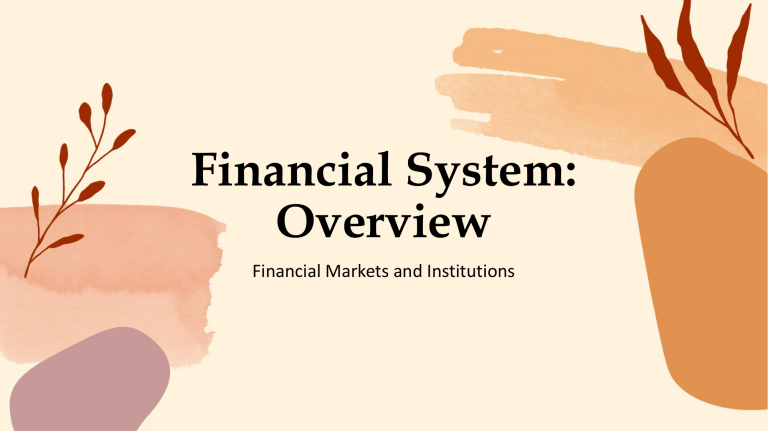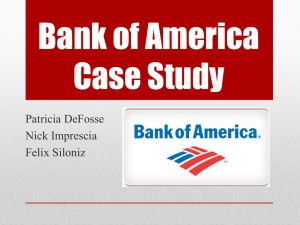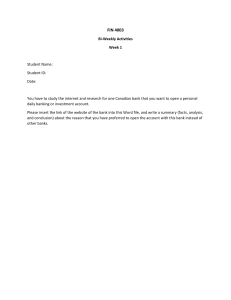
Financial System: Overview Financial Markets and Institutions What is a financial system and its functions • What is a financial system? • It is an economic arrangement wherein financial institutions facilitate the transfer of funds and assets between borrowers, lenders, and investors. [WallStreetMojo] • Its goal is to efficiently distribute economic resources to promote economic growth and generate an ROI for market participants. What is a financial system and its functions • What is a financial system? • It is the set of global, regional, or firmspecific institutions and practices used to facilitate the exchange of funds. [Investopedia] • It also includes sets of rules and practices that borrowers and lenders use to decide which projects get financed, who finances projects, and the terms of financial deals. Components of Financial System • Money • Financial Institutions • Financial Markets • Financial Instruments • Regulatory Agencies • Central Bank Goal of Financial System • What is a financial system? • Its goal is to efficiently distribute economic resources to promote economic growth and generate an ROI for market participants. What is a financial system and its functions • What is the function of the financial system? • Providing a way of making payments (banks) • Giving participants a way of earning interest in the form of time value (investment institutions) • Protecting them against financial risks (insurance) • Collecting and distributing financial information (credit agencies) • Governing regulations to maintain stability (central banks and governments) • Maintaining liquidity and converting investments into cash (banks and financial institutions) (WallStreetMojo) Functions of the financial system • Three (3) key services • Risk-sharing • Liquidity • Information RISK-SHARING (Example) • Group life insurance • Joint venture of developing a new product. • Engaging a subcontractor as a delivery service provider. RISK-SHARING • Risk is something that involves uncertainty about the effects/implications of an activity with respect to something that humans value (such as health, well-being, wealth, property, or the environment) [Wikipedia] • Risk is the chance that the value of financial assets will change relative to what one expects. RISK-SHARING or RISK DISTRIBUTION • It is form risk management that involves dividing the risk among two or more parties who agree to cooperate and share the outcomes, whether positive or negative. • Diversification – is the splitting of wealth into many assets to reduce risk. RISK-SHARING (Benefits) • It allows savers to hold many assets, such as buying more stocks, bonds, and other financial assets. • It increases the borrower’s opportunity to raise funds in the financial system. LIQUIDITY • It refers to the efficiency or ease with which an asset or security can be exchanged for money which savers view as a benefit or can be converted to cash without affecting its market price. • The more liquid an asset is, the easier and more efficient it is to turn it back into cash. • The less liquid assets take more time and may have a higher cost. LIQUIDITY • Securitization – it is the conversion of an asset, especially a loan, into marketable securities, typically for the purpose of raising cash by selling them to other investors. INFORMATION • This information refers to those facts about borrowers and expectations of returns on financial assets. • Bank collect information on borrowers to forecast their likelihood of repaying loans. • This information help one decide on whether to continue investing in the securities previously purchased or to sell more stocks or bonds to finance a planned expansion. ASYMMETRIC INFORMATION • It describes the situation which one party to an economic transaction has better information than does the other party. Problems arising from asymmetric information • Adverse selection • Moral Hazard PROBLEMS OF ADVERSE SELECTION AND MORAL HAZARD • Adverse selection is the phenomenon that bad risks are more likely than good risks. • It refers to a situation where sellers have more information than buyers have, or vice versa, about some aspect of product quality, although typically the more knowledgeable party is the seller. • Adverse selection is seen as very important for life insurance and health insurance. Adverse Selection (Example) PROBLEMS OF ADVERSE SELECTION AND MORAL HAZARD • Moral Hazard is the phenomenon that having insurance may change one’s behavior. • In a moral hazard situation, one party entering the agreement provides misleading information or changes their behavior after the agreement has been made because they believe that they won’t face any consequences for their actions. Moral Hazard (Example) • A homeowner who lives in a flood zone area but does not maintain flood insurance, will be more careful when there is a typhoon by clearing the drainage and securing the furniture to avoid or prevent damages. • However, a homeowner who has a flood insurance will be less careful because they know that they house is insured. Moral Hazard vs. Adverse Selection • There is information asymmetry between the two parties in both moral hazard and adverse selection. • The difference is when it occurs. • In moral hazard, the change in the behavior of one party occurs after the agreement has been made. • In adverse selection, there is a lack of asymmetry information prior to when the contract or deal is agreed upon. Nature and Impact of Transactions and Information Costs • Transaction costs are expenses incurred when buying or selling a good or service. • It is the cost of a trade or a financial transaction. • It represents the labor required to bring a good or service to market, giving rise to entire industries dedicated to facilitating exchanges. • It includes broker’s commission charged for buying or selling a financial assets. Nature and Impact of Transactions and Information Costs • Information costs is the costs that savers incur to determine the creditworthiness of borrowers and to monitor how they use the funds acquired. How Financial Intermediaries Reduce “Adverse Selection”. 1. Requiring borrowers to disclose material information on their financial performance approaches. 2. Collecting information on firms and selling that information to investors. 3. Convincing lenders to require borrowers to pledge some of their assets as collateral which the lender can claim if the borrower defaults. How Financial Intermediaries Reduce “Moral Hazard”. 1. Specializing in monitoring borrowers and developing effective techniques to ensure that the funds they loan are actually used for their intended purpose. 2. Imposing restrictive covenants How Financial Intermediaries Reduce “Transaction costs”. 1. Financial intermediaries take advantage of economies of scale which refers to the reduction in average cost that results from an increase in the volume of a good or service produced. 2. Financial intermediaries also take advantage of technology to provide financial services. 3. Use of sophisticated software to evaluate the creditworthiness of loan applicants. Assignment 1. What are the plans or strategy/ies that the Philippine government is making to address the current risk in the Philippine Financial System? 2. What is the difference between a dealer and a broker? 3. What are the signs of growth in the domestic market? Assignment 4. What the different types of bank and non-bank financial institutions? What are their functions? Give an example of bank and non-bank financial institutions according to type. The Philippine Financial System Financial Markets and Institutions STRUCTURE OF FINANCIAL SYSTEM IN THE PHILIPPINES. 1. Bangko Sentral Ng Pilipinas (BSP) 2. Banking Institutions 1. 2. Private Banking Institutions Government Banking Institutions 3. Non-Bank Financial Institutions (NBFI) 1. 2. Private NBFI Government NBFI PRIVATE BANKING INSTITUTIONS (TYPES) Universal Bank – Expanded Commercial Bank (EKB) - Any commercial bank, which performs the investment house function in addition to its commercial banking authority. - Commercial banking services offers consumer and business services (checking and savings account; business and personal loans) - Investment banking services provide merger and acquisition services for corporations, underwriting, and brokerage services. PRIVATE BANKING INSTITUTIONS (TYPES) Universal Bank – Example: - Metrobank Landbank BDO PNB PRIVATE BANKING INSTITUTIONS (TYPES) Commercial Bank– (KB) - Any commercial bank, that is confined only to commercial banking functions - Example: - AUB (Asia United Bank) A Fil-Taiwanese JV Bank Bank of Commerce – SMC affiliate BPI – oldest bank in SEA (owned by Ayala) China Bank (SM Group member) CIMB Bank – digital bank (Gcash App) PRIVATE BANKING INSTITUTIONS (TYPES) Thrift Banks – (TB) - It is a type of institution that specializes in offering savings accounts and originating home mortgages for consumers. - Example: - Philippine Savings Bank Robinsons Bank Philippine Business Bank EastWest Bank PRIVATE BANKING INSTITUTIONS (TYPES) Rural Bank – (RB) - It is a bank authorized by the Central Bank to accept deposits and make credit available to farmers, businessmen, and cottage industries in rural areas. PRIVATE BANKING INSTITUTIONS (TYPES) Cooperative Banks – (RB) - It is a bank established to assist the various cooperatives by lending those funds at reasonable interest rates. - It work on the principle of cooperation and are owned and operated by their members. GOVERNMENT BANKS OR SPECIALIZED BANKING INSTITUTIONS (TYPES) Development Bank of the Philippines – (DBP) - It provides loans for developmental purposes and loans to agricultural, commercial, and industrial sectors. GOVERNMENT BANKS OR SPECIALIZED BANKING INSTITUTIONS (TYPES) Land Bank of the Philippines – (LBP) - It is a government bank that provides financial support in the implementation of the Agrarian Reform Program (CARP) of the government. GOVERNMENT BANKS OR SPECIALIZED BANKING INSTITUTIONS (TYPES) Al-Amanah Islamic Investment Bank - RA 6048 provides for its charter. - Under RA 6048, it authorizes Al-Amanah Investment Bank to promote and accelerate the socio-economic development of the Autonomous Region of Muslim Mindanao (ARMM) by performing banking, financing, and investment operations, and to establish and participate in agriculture, commercial, and industrial ventures based on the Islamic concept of banking NON-BANK FINANCIAL INSTITUTIONS PRIVATE NON-BANK FINANCIAL INSTITUTIONS Investment House Investment Banks Financing Company Securities Dealer Saving and Loans Associations (S&Ls) Pawnshops Lending Investors Pension Funds Insurance Companies Credit Unions Mutual Funds NON-BANK FINANCIAL INSTITUTIONS GOVERNMENT NON-BANK FINANCIAL INSTITUTIONS 1. Government Service Insurance System (GSIS) 2. Social Security System (SSS) 3. Pag-IBIG Fund NON-BANK FINANCIAL INSTITUTIONS INVESTMENT HOUSE/INVESTMENT BANKING FIRMS/INVESTMENT BANKS - Any enterprise that engages in underwriting securities of other corporations. - It also generates income from sale of investments in securities. Investment House/Investment Bank/Investment Banking Firms What do investment banks do that other banks are not authorized to do? - They help corporations raise money or capital funds through new equity shares, private placements or debts. - They help institutional investors such as mutual funds, pension funds, and insurance companies invest their money. - They buy or sell securities on behalf of their institutional clients. Investment House/Investment Bank/Investment Banking Firms What do investment banks do that other banks are not authorized to do? - They advise corporations on mergers and acquisitions. - They help in the restructuring and reorganization of a company. - They bring investors together with companies that issue securities or broker securities. - They manage financial portfolios on behalf of clients. - They do financial research, publish and market financial products. Investment House/Investment Bank/Investment Banking Firms What do investment banks do that other banks are not authorized to do? - They advise corporations on mergers and acquisitions. - They help in the restructuring and reorganization of a company. - They bring investors together with companies that issue securities or broker securities. - They manage financial portfolios on behalf of clients. - They do financial research, publish and market financial products. Investment House/Investment Bank/Investment Banking Firms Example - BDO Capital Investments and Holdings Inc - BPI Capital Corp - Chinabank Capital Corp - Unicapital Inc - State Investment Trust Inc Financing Company - Its primary purpose is to extend credit facilities to consumers and to industrial, commercial, or agricultural entities either by discounting or factoring commercial papers or accounts, or buying installment contracts, leases, chattel mortgages, or other evidences of indebtedness. Financing Company Example: - BDO Financing Company - Kabayan Financing Corporation - Orix Metro Leasing and Finance Corp - https://www.sec.gov.ph/wp-content/uploads/2020/06/20200531_List-of-Financing-Companiesas-of-31-May.pdf Securities Dealer - Any person or entity engaged in the business of buying and selling securities for his own or its client’s account. - A dealer in the securities market is an individual or firm who stands ready and willing to buy a security for its own account (at its bid price) or sell from its own account (at its ask price). A dealer seeks to profit from the spread between the bid and ask prices, while also adding liquidity to the market. Securities Dealer - Dealers are regulated by the Securities and Exchange Commission (SEC). - As part of the regulation, all dealers and brokers must register with the SEC and must be members of the Financial Industry Regulatory Authority (FINRA). [Source: Investopedia] DEALER VS. BROKER [Investopedia] DEALER Trades directly for its portfolio. BROKER Does not trade for its portfolio but instead facilitates transactions by bringing buyers and sellers together. A dealer will charge a markup A broker charges a client a when selling from their own commission for executing inventory because the dealer trades on their behalf. is principal in the account. SAVINGS AND LOANS ASSOC. • It serves to individual savers and residential and commercial mortgage borrowers. • It accumulates funds of many small savers and then lends this money to home buyers and other types of borrowers. • It creates liquidity. MUTUAL FUNDS • It is a corporation that accepts money from savers and then uses these funds to buy stocks, long-term bonds, and shortterm debt instruments issued by businesses or government units. • It pools funds and reduces the risks by diversification. PAWNSHOPS • It refers to a person or entity engaged in lending money with personal property, jewelry, and other durable goods as collateral for the loans given. LENDING INVESTOR • Any person or entity engaged in the business of effecting securities transactions, giving loans and earns interest from them. PENSION FUNDS • A retirement plan funded by corporations or government agencies for their workers. • It is administered primarily by the trust departments of commercial banks or by life insurance companies. • It invests primarily in bonds, stocks, mortgages, and real estate. INSURANCE COMPANIES • It takes savings in the form of annual premiums, then they invest these funds in stocks, bonds, real estate, and mortgages. CREDIT UNIONS • It is a cooperative association whose members have a common bond, such as being employees of the same firm. • Member’s savings are loaned only to other members. • This is the cheapest source of funds available to individual borrowers. GOVERNMENT NON-BANK FINANCIAL INSTITUTIONS • GSIS – it provides retirement benefits housing loans, personal loans, emergency loans, and calamity loans to government employees. • SSS – it provides retirement benefits, funeral benefits, housing loans, personal loans, and calamity loans to employees who are working in private companies and those who are self-employed. • HDMF – it provides housing loans to both government and private employees and to self-employed individuals. It provides housing loans to its members. THE EVOLVING PHILIPPINE FINANCIAL SYSTEM CURRENT RISK IN THE PHILIPPINE FINANCIAL SYSTEM • REPRICING – it is the risk of changes in the interest rate charged (earned) at the time a financial contract’s rate is reset. CURRENT RISK IN THE PHILIPPINE FINANCIAL SYSTEM • REFINANCING RISK – aka ROLLOVER RISK. - It is the risk of being unable to refinance existing debt with new debt. - EFFECT? • It can result in higher interest rates • The need to repay the debt in full • Putting financial strain on individuals, organizations, banks, and financial institutions. ADVANTAGES OF REFINANCING RISK • Raising short-term funds at a cheaper cost to fund long-term projects. • Low-interest rate cycles, individuals can refinance their debts at a lower cost. DISADVANTAGES OF REFINANCING RISK • If there is a failure to refinance mature liabilities, it can lead to default and can cause the bankruptcy of the company despite the company being able to meet its day-to-day operations. • Refinancing risk increases business costs as interest won’t remain the same forever. CURRENT RISK IN THE PHILIPPINE FINANCIAL SYSTEM • Repayment risk – is the probability of a financial loss resulting from a borrower’s failure to repay a loan (Investopedia) DEVELOPMENTS IN THE CREDIT MARKET • Local intermediation continues to be peso-funded but with some support from foreign currency. • Banks have increased their foreign currency debts to augment growth in domestic currency loans. CONTINUOUS DEMAND FOR CREDIT BY CORPORATE ENTERPRISES AND HOUSEHOLDS IS EVIDENT IN THE DOMESTIC ECONOMY • Financial deepening – an increased ratio of money supply to GDP or some price index. It refers to liquid money. The more liquid money is available in the economy, the more opportunities for continued growth. (unescwa.org) • However, if there is a continued demand, there is a high risk as well of repricing, refinancing, and repayment. ASSIGNMENT (Prepare for a long quiz next meeting) Coverage Chapter 6, 7, and 8







